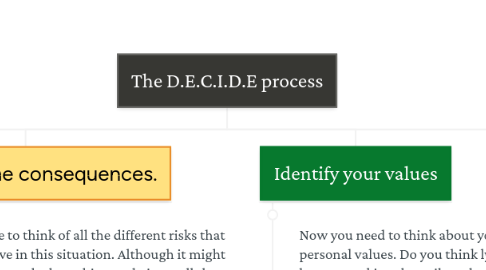The D.E.C.I.D.E process
作者:Aniket Verma

1. Define the problem
1.1. You borrowed a device from somebody else and when you were using it you accidentally broke it.
2. Explore the Alternatives
2.1. Now, you need to think of what you can do to fix the problem. In this case, you can directly go to the person and tell them you broke the device, hide it from them or get the device fixed yourself and then give it back to them.
3. Consider the consequences.
3.1. Now you have to think of all the different risks that you might have in this situation. Although it might upset the person, the best thing to do is to tell them that you broke the device. You will not lose the trust with that person if you do this. From here on out, you can set up a plan to fix the device. A non- practical thing to do is to hide the evidence from the person. This is called taking an ostrich approach. Although your friend may not know now, they will ultimately figure out in the future. You will most likely lose trust with this person if you take this approach. Another approach can be fixing the phone and then giving it to them. This can work and not upset the person, but the owner of the device might spot a difference in the device. Lastly, you can blame it on another person. But doing this can lead to you losing trust in both people.
4. Identify your values
4.1. Now you need to think about your own personal values. Do you think lying is better or taking the guilt and telling the person is better? You can also think to yourself, how would you feel if someone lied about breaking something that belongs to you? How would you feel if they told the truth?
5. Decide and act
5.1. Think of everything that you have just learned from the D.E.C.I.D.E process so far. If you are an honest person, it is the best to straight up tell your friend. If I were in this situation, I would tell the person I broke their device and get the situation over with, although I would be hesitant. If you acted properly, the situation will become better, if not, anything can happen.
6. Evaluate the results
6.1. Now for the final steps, reflect on the decision that you made. Look at the decision you made and think, could there have been a better decision? Out of all the decisions, telling the truth and not losing the trust with the other person would have been the best decision, unlike lying. Since the trust was still there in the friendship, you emotional and social wellness was not harmed in any way which was beneficial to your health.


